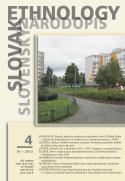IDENTITA MODERNÍCH MĚSTSKÝCH SVĚTŮ (PŘÍKLAD PRAHY V OBDOBÍ OD ŠEDESÁTÝCH LET 19. STOLETÍ DO TZV. SAMETOVÉ REVOLUCE /1989/)*
THE IDENTITY OF MODERN CITY WORLDS
Author(s): Blanka SoukupováSubject(s): Anthropology
Published by: SAV - Slovenská akadémia vied - Ústav etnológie a sociálnej antropológie Slovenskej akadémie vied
Keywords: identity; city of Prague; nationalities; tradition; modernisation; myth
Summary/Abstract: The identity of every modern national cityarose not only from its history and traditions, but primarily from delimiting itself in relation to other, different, foreign identities. This delimitation naturally had not only politico-social and cultural repercussions, but also its symbolic level (including the language one). Prague, the capital of the Czech lands, from the 1860s unequivocally a Czech city, had, in its modern history, to delimit itself in relation to states on whose territory it was located. (Until October 28, 1918, it was a third class provincial capital of the Austro-Hungarian Monarchy; afterwards, until March 15, 1939, capital of the sovereign First and truncated Second Czechoslovak Republic; from March, the capital of the Protectorate of Bohemia and Moravia under the direct influence of Nazi Germany, and after liberation in May 1945, the capital of the renewed Czechoslovak Republic, which, however, became a satellite state of the Soviet Union). At the same time, however, Prague represent, until 1941, the space where fates of the Czech majority and the German and Jewish structured majorities (mainly they were people who assimilated; from the 1890s the Zionist ideology began to have influence in Prague) met and merged. Jewish Orthodoxy was the minority orientation. This merge of three elements, typical of a number of Central European cities, ended with the tragedy of Jewish transports during the Second World War (in 1943 Prague was, according to the Nazis, already a “pure” city) and the expulsion (from May 1945) and displacement (from January 1946 to the end of that year) of the Prague Germans. The ethnic variety of Prague during the interwar period was supplemented by Ukrainian, Russian and Byelorussian anti-Bolshevik inclined emigration. In contrast to the pre-war situation, after the Communist Revolution of February 1948, Prague was a nationally virtually homogeneous city. The second pillar of Prague identity (alongside its relation to the state)thus created a range of manifestations of national polarization which appeared on the socio-political level, the cultural-political level and also in daily life. The Czech Germans were thus the most important group compared to whom the Czechs nationally delimited themselves. Except during the Hitler period, respect for the Germans from Germany prevailed. As a certain Prague specificity, one could consider the prevailing moderation of ethnic conflicts, especially in the golden age of Czech democracy – the period of the First Republic – called an island of peace and democracy. In the era of the Sovietized city, then, the construct of the missing internal national enemy was replaced by the construct of the enemy imperialist camp compared to which the exemplary socialistic Prague was forced to define itself with no less intensity.
Journal: Slovenský národopis
- Issue Year: 61/2013
- Issue No: 4
- Page Range: 338-350
- Page Count: 13
- Language: Czech

